


SITE LOGIN
-
REVIEWS
- Ski Gear
- Clothing
- Accessories
- Off-Season Gear
- Lifestyle
- Lodges and Accommodation
- Nutrition
- Manufacturers
- Destinations
- Training
- Gear of the Year
- Best New Summer Gear
-
Holiday Gift Guide
-
Holiday Gift Guide 2024
- Holiday Gift Guide 2024 Base Layers
- MSR Explore Revo Snowshoes
- Fieldsheer Backcountry Heated Jacket
- Fieldsheer Premium 2.0 Merino Heated Socks
- MEC Hut Booties and Slippers
- Arc’teryx Kopec GTX Shoe
- Arc’teryx Kragg Insulated Approach Shoes
- Gregory Verte 18 Backpack
- Grundens Deck-Boss Ankle Boot
- MEC Northern Light Vest
- Montec-Scope-Ski-Goggles
- Mountain Hardware Kor Airshell Hoody
- Mountain Hardware Kor Alloy Crew
- Arcade Atlas Belt
- Dynafit Ridge Dynastretch Jacket
- Shokz OpenRun Pro 2 headphones
- Buff Merino Move Multifunctional Neckwear
- Bootdoc Foot Warmer
- Cotopaxi Allpa 42L Travel Pack
- DPS LastBag
- DPS PHANTOM Glide At-Home Kit
- DPS Mission Quiver Roller
- Dragon Amped sunglasses
- Dragon DX3 Plus OTG photochromic goggle
- Fuse Lenses Anclote Flashback
- Garmin Fenix 8 Solar Sapphire Watch
- Gregory Alpaca Gear Tote 30
- Hotronic Boot Dryer
- MEC Aluminum Pot Set
- Gnara Go There Pants
- Grundens Shackleton 2.0 Duffel
- Jones Deeper 19L Backpack
- Le Bent Core Midweight Crew base layer
- Leatherman ARC
- Montane Nordes Hooded Softshell Jacket and Pants
- Helly Hansen Odin Everdown Hooded Jacket
- Helly Hansen Verglas Infinity Shell Jacket 2.0
- Montec Fawk Ski Jacket
- Pomoca Free Pro 2.0 Skins
- Rab Glaceon Pro Down Jacket
- Rab Khroma Converge GORE-TEX Ski Jacket & Pants
- Smith Squad MAG Goggles
- Stellar Guide Aerogel Hybrid Hood 2.0
- Stellar Ultralight Down Hood 2.0
- Arms of Andes Alpaca Half Zip & Wool Leggings
- Cotopaxi Allpa 70L Duffel Bag
- Giro Taggert Mips Helmet
- Loonr Hi Flyer Boots
- Paka Mountain Crew
- Roll Recovery SUPERPLUSH Classic Shoes
- Smartwool Smartloft Hooded Jacket and Pants
- Ortovox Switchback 32 Ski Touring Backpack
- Cotopaxi Allpa X 3L Hip Pack
- Giro Sagen Ski Goggle
- Icebreaker Ski+ Over the Calf Socks
- MEC-Fireside-Fleece-Snap-Pullover
- Montec Roast Mittens
- Mountain-Hardware-Sunblocker-Hoody
- MSR Titan Kettle 900 ml
- Tailgate-Industries-The Gondom-Goggle-Cover
- Wild Country Rope Tarp
- Bootdoc Race Merino PFI 50 Socks
- Remind Soles Destin Impact Insoles
- Kari Traa Rose Baselayer Half Zip Top and Pants
- Le Bent Midweight Quarter Zip
- Ombraz Dolomite Sunglasses
- Ortovox Fleece Rib Hoody
- Ortovox Merino Thermovent Base Layer
- Smartwool Intraknit Merino Tech Half Zip
- Suunto Wing Bone Conduction headphones
- Sweet Protection Adapter Mips Helmet
- Sweet Protection Connor Rig Reflect Goggles
- Zeal Optics Selkirk Glacier Glasses
- Norrona more flex1 Pants
- Norrona Octa Zip Hood
- Norrona Lyngen Alpha100 Zip Hood
- MEC Deluxe Pillow
- Holiday Gift Guide 2023
- Holiday Gift Guide 2022
- Holiday Gift Guide 2021
- Holiday Gift Guide 2020
- Holiday Gift Guide 2019
- Holiday Gift Guide 2018
- Holiday Gift Guide 2017
- Holiday Gift Guide 2016
-
Holiday Gift Guide 2024
- Pro Skier Interviews
- NEWS
- STORE
- ROUTES
- LODGING
-
VIDEOS
- 2022/23 Gear Reviews
- 2021/22 Gear Reviews
- 2020/21 Gear Reviews
- 2019/20 Gear Reviews
- 2018/19 Gear Reviews
- 2017/18 Gear Reviews
- 2016/17 Gear Reviews
- 2015/16 Gear Reviews
- 2014/15 Gear Reviews
- 2013/14 Gear Reviews
- 2012/13 Gear Reviews
- 2011/12 Gear Reviews
- 2020 Outdoor Retailer
- 2019 Outdoor Retailer
- 2018 Outdoor Retailer
- 2017 Outdoor Presscamp
- 2017 Outdoor Retailer
- 2016 Outdoor Presscamp
- 2016 Outdoor Retailer
- 2015 SIA Show
- 2014 Outdoor Retailer
- 2013 SIA Show
- 2012 Outdoor Retailer
- Tips and Tricks
- Backcountry Skiing
- SAFETY
- ABOUT
- REVIEWS
- NEWS
- STORE
- ROUTES
- LODGING
-
VIDEOS
- 2022/23 Gear Reviews
- 2021/22 Gear Reviews
- 2020/21 Gear Reviews
- 2019/20 Gear Reviews
- 2018/19 Gear Reviews
- 2017/18 Gear Reviews
- 2016/17 Gear Reviews
- 2015/16 Gear Reviews
- 2014/15 Gear Reviews
- 2013/14 Gear Reviews
- 2012/13 Gear Reviews
- 2011/12 Gear Reviews
- 2020 Outdoor Retailer
- 2019 Outdoor Retailer
- 2018 Outdoor Retailer
- 2017 Outdoor Presscamp
- 2017 Outdoor Retailer
- 2016 Outdoor Presscamp
- 2016 Outdoor Retailer
- 2015 SIA Show
- 2014 Outdoor Retailer
- 2013 SIA Show
- 2012 Outdoor Retailer
- Tips and Tricks
- Backcountry Skiing
- SAFETY
- ABOUT
TOP VIDEOS
Brooks-Range Ultralite Rescue Sled
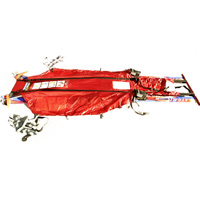 For well over a decade now we have been preached to about the necessity to carry the three essentials for backcountry skiing safety, namely probe, beacon and shovel. There are many other things that we all carry (or at least should) such as extra food/water and a good warm layer of down. On the outskirts our 'safety gear' list is likely a first aid kit, map/compass, repair kit, and headlamp - yes it's true some people don't have these in their packs (why do you think they can ski tour with a 30 litre pack?). Not even on the farthest reaches of ones radar is the idea of carrying a rescue sled.
For well over a decade now we have been preached to about the necessity to carry the three essentials for backcountry skiing safety, namely probe, beacon and shovel. There are many other things that we all carry (or at least should) such as extra food/water and a good warm layer of down. On the outskirts our 'safety gear' list is likely a first aid kit, map/compass, repair kit, and headlamp - yes it's true some people don't have these in their packs (why do you think they can ski tour with a 30 litre pack?). Not even on the farthest reaches of ones radar is the idea of carrying a rescue sled.
It should be. Read on.
So, I have my AST2 course fresh in my mind, I know how to recognize avalanche terrain and safely manage it and route find accordingly. I have taken into account the current and future weather patterns and have my trusty probe, beacon, shovel (and know how to use them all efficiently). My pack even contains a first aid kit, warm down jacket and spare gloves and my trusty 'bag of tricks' that has among other things in it: compass, Brooks-Range backcountry multi-tool, repair kit and head lamp (including spare batteries). So I am knowledgeable and prepared - what could go wrong. Well, truthfully - anything, and if it does and someone gets injured due to a tree well, avalanche, bad skiing or just bad luck - then what?
You may only be 5km from the car but with your skiing buddy not able to ski or skin out due to injury you are not going anywhere fast, or rather anywhere at all. Think about the other side of all that safety gear you currently carry - you have it to stay safe and repair your gear and yourself but if you get hurt what exactly is your plan to get back to safety? Leaving your buddy in the backcountry is not ideal and even with a party of 5 on a cabin trip having to move an injured person even 500 metres is going to take you most of the day.
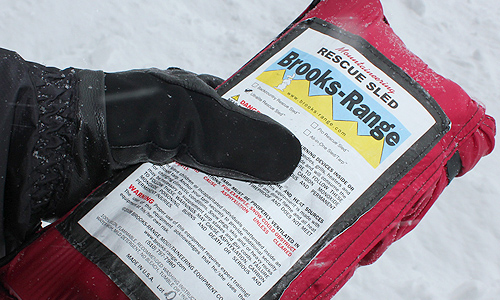
This is where the Brooks-Range Ultralite Rescue Sled comes into the equation. Brooks-Range is a company fast becoming know for designing and producing innovative backcountry rescue gear, from bivies and avi gear to the three rescue sleds they currently offer. The lightest and most suited to backcountry skiers is the Brooks-Range Ultralite Rescue Sled which weighs in at 705.9 grams or slightly more than a thermos of hot tea. The Ultralite Rescue Sled is comprised of five 24" backcountry ski straps and two Pro Stretcher Bars that are made up of four nested aircraft quality aluminum locking bars which are all contained within the ultralite rip-stop nylon sled, 'taco roll' style. The entire package is quite compact and packs down to the size of a small down jacket (4 x 11 x 2"). It gives you everything you need (except for the tow rope) to build a solid sled out of the subjects skis and poles and securely fasten them for transportation.
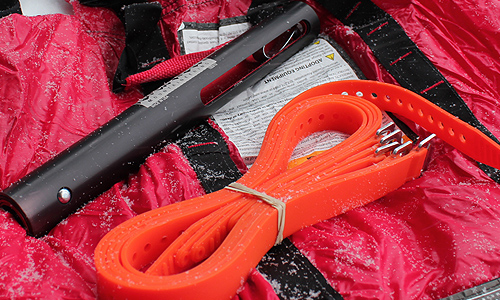

The construction of the sled is relatively fast but like anything you need to practice this multiple time in the comfort and security of your living room before venturing out. If you build it properly the Brooks-Range Ultralite Rescue Sled is unbelievably rigid and sturdy - build it improperly and it will not get you far. Attached to the red nylon fabric are built-in carry handles which are reinforced for lifting the subject vertically and all the tie down straps you will need to secure the subject. Diagrams on how to build the sled are featured on the inside of the nylon fabric incase you get confused along the way and the straps are all colour coded. The Brooks-Range Ultralite Rescue Sled slides along the snow on the subjects skis and moves easily and quickly as there is nothing impeding the forward motion. (Please note: The Brooks-Range Ultralite Rescue Sled is not intended to be used as a back board but only as an emergency transportation product.)
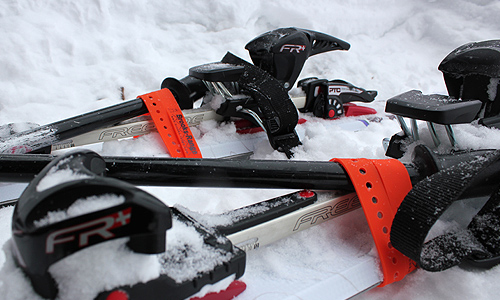

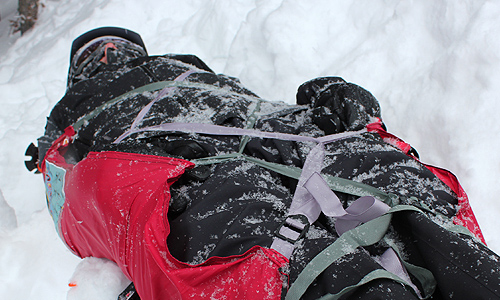

The basic steps for constructing the sled are:
1. Unpack the Brooks-Range Ultralite Rescue Sled
2. Prepare the Pro Stretcher Bars (lock the 2 red bars together and 2 black bars together)
3. Place the skis into the Pro Stretcher Bar slots
4. Secure the poles with five 24" Backcountry Ski Straps to form the sled platform and the cross bracing
5. Place the red nylon sled material over the constructed sled platform (skis and poles) and tension the straps so that everything is held into place
6. Place the subject onto the sled (you may want to insulate them with a sleeping mat or jackets as they will get cold and possibly hypothermic)
7. Secure the subject to the sled with the two straps in a crisscross pattern
8. Affix a tow rope to the sled and begin transportation
For additional information on how to assemble and use the Brooks-Range Ultralite Rescue Sled
have a look at this video.
SPECS:
Cost: $238 US
Colour: red
Weight: 24.90oz / 705.90g
Size: self taco rolled to 4 x 11 x 2" or 10.16 x 27.94 x 5.08cm
Requirements: Skis of any width and lengths from 135cm to 205 cm
PROS:
Compact and light, easy to build (with practice), well thought out design with built in instructions.
CONS:
Pro stretchers bars hard to fit on bigger fat ski tips.
Rating: 8/10
Innovation 2/2
Function 1.5/2
Features 1.5/2
Weight 1.5/2
Quality / Price 1.5/2
This is only our opinion. Do you disagree? Did we miss something? Are we totally out to lunch? Join the discussion in the forums here, and let us know what you think. People like/dislike gear for different reasons so chime in and we'll get a well-rounded evaluation.
Back to the rest of the reviews.
Copyright © 2023-24 Backcountry Skiing Canada. All Rights Reserved.







